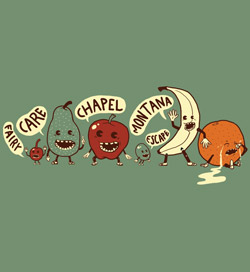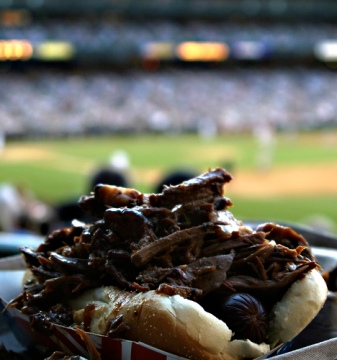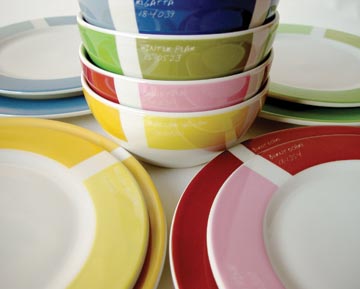Archive for May 22nd, 2007|Daily archive page
Nothing Rhymes With Orange

Another good lookin’ Threadless food-themed t-shirt.
I think it’d look cool in orange. $15 for guys, $17 for gals and kids.
These are the reprint batch, meaning the first round sold out. Get yours while their still hot.
Fenway’s for Foodies

As a sports fan, it’s always kind of fascinating to see how teams are changing with the times. And according to Slashfood and this article, Fenway Park in Boston is trying to class up it’s concession stands a bit.
It used to be that Ron Abell’s idea of a large crowd was dinner for 200. Now it’s more like 35,000.
The former chef de cuisine of Icarus in the South End is now executive chef at Fenway Park. That means he’s left one small kitchen to oversee six, and serves food to fans in the stands, in the luxury suites, in the park’s private EMC Club and State Street Pavilion, even some of the players in the clubhouse.
New menu items include a turkey wrap with mesclun greens and a steak sandwich with baby arugula and aioli. While he is adamant that staple foods will always be available, he is excited about something like lobster roll, a simple mixture of mayonnaise, celery, Tabasco sauce, lobster meat, and other seasonings on a buttered, toasted roll (it sells for $16).
But Fenway isn’t the only stadium classing is up. You can also get crabcakes at Camden Yards, an Ahi Tuna Sandwich at AT&T Park, a Cuban Panini at Miller Park, Garlic Fries at Pac Bell Park and Dodger Stadium…but according to ESPN’s Page 2 Stadium Review, Safeco Field takes the cake.
You’ve got all the classic stand-bys; but you’ve also got clam chowder, salmon sandwiches, sushi, chocolate-covered strawberries, garlic fries, wok-fried noodles, southern barbeque and much, much more. If Mo Vaughn knew about this, he would have insisted on a trade to the Mariners.
And in Yankee news…
Yankee Stadium finally wakes up to its massive Latino customer base and starts serving foods like empanadas and papas rellenas. (Grub Street)
For more on the Yankees latin food you’ll have to register with the New York Times.
Photo above from Flickr.
Pantone Plates

Apparently I’m a little late on these (they launched in 2005) but the Pantone Collection are really great looking kitchen-ware whether you’re a designer or not.
Inspired by vintage traveling salesmen’s samples from the Fishs Eddy archive, the dishes are decorated with a pattern resembling the iconic PANTONE Color Chip, complete with color name and PANTONE Number, in palettes developed by Pantone’s design team. The open stock group includes a dinner plate (MSRP $12) and color–coordinated side salad/dessert plate ($8.50), soup/cereal bowl ($9.50) and mug ($7.50), and is available in four colorways: Sahara Sun, Lettuce Green, Dusk Blue and Burnt Ochre. (from Pantone)
Those were the launch prices back in 2005, but you can now get them for a lot less. The bowls are down to $6.97, the plates are $6.97, and the 10 oz mugs are $5.57. Pretty good deal for some fine looking plates.
The PANTONE UNIVERSE Palette Plates Collection are on sale at all Fishs Eddy stores, as well as online at www.fishseddy.com.
You can also find other PANTONE UNIVERSE products at www.pantoneuniverse.com.
Oh, and in case you don’t know what pantone is or means, here’s what Wikipedia says:
The Pantone Color Matching System expands upon existing color reproduction systems such as the CMYK process. The CMYK process is a standardized method of printing color by using four inks—cyan, magenta, yellow and black. The majority of the world’s printed material is produced using the CMYK process. The Pantone system is based on a specific mix of pigments to create new colors—referred to as spot colors. The Pantone system also allows for many ‘special’ colors to be produced such as metallics and fluorescents. While most of the Pantone system colors are beyond the printed CMYK gamut, those that are possible to simulate through the CMYK process are labeled as such within the company’s guides.
Pantone colors are described by their allocated number (typically referred to as ‘PMS 130’). PMS colors are almost always used in branding and have even found their way into government legislation (to describe the colors of flags). In January 2003, the Scottish Parliament debated a petition (reference PE512) to define the blue in the Scottish flag (saltire) as ‘Pantone 300’. Countries such as Canada and South Korea and organizations such as the FIA have also chosen specific Pantone colors to use when producing flags. It is open to speculation whether legislators realize that Pantone may choose to reformulate the color.
 Comments (7)
Comments (7)






















